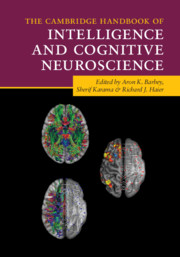Book contents
- The Cambridge Handbook of Intelligence and Cognitive Neuroscience
- Reviews
- The Cambridge Handbook of Intelligence and Cognitive Neuroscience
- Copyright page
- Dedication
- Contents
- Figures
- Tables
- Contributors
- Preface
- Part I Fundamental Issues
- Part II Theories, Models, and Hypotheses
- Part III Neuroimaging Methods and Findings
- 10 Diffusion-Weighted Imaging of Intelligence
- 11 Structural Brain Imaging of Intelligence
- 12 Functional Brain Imaging of Intelligence
- 13 An Integrated, Dynamic Functional Connectome Underlies Intelligence
- 14 Biochemical Correlates of Intelligence
- 15 Good Sense and Good Chemistry
- Part IV Predictive Modeling Approaches
- Part V Translating Research on the Neuroscience of Intelligence into Action
- Index
- References
12 - Functional Brain Imaging of Intelligence
from Part III - Neuroimaging Methods and Findings
Published online by Cambridge University Press: 11 June 2021
- The Cambridge Handbook of Intelligence and Cognitive Neuroscience
- Reviews
- The Cambridge Handbook of Intelligence and Cognitive Neuroscience
- Copyright page
- Dedication
- Contents
- Figures
- Tables
- Contributors
- Preface
- Part I Fundamental Issues
- Part II Theories, Models, and Hypotheses
- Part III Neuroimaging Methods and Findings
- 10 Diffusion-Weighted Imaging of Intelligence
- 11 Structural Brain Imaging of Intelligence
- 12 Functional Brain Imaging of Intelligence
- 13 An Integrated, Dynamic Functional Connectome Underlies Intelligence
- 14 Biochemical Correlates of Intelligence
- 15 Good Sense and Good Chemistry
- Part IV Predictive Modeling Approaches
- Part V Translating Research on the Neuroscience of Intelligence into Action
- Index
- References
Summary
Functional brain imaging studies of intelligence have tackled the following questions: What happens in our brains when we solve tasks from an intelligence test? And are there differences between people? Do people with higher scores on an intelligence test show different patterns of brain activation while working on cognitive tasks than people with lower scores? Answering these questions can contribute to improving our understanding of the biological bases of intelligence. To investigate these questions, researchers have used different methods for quantifying patterns of brain activation changes and their association with cognitive processing – including electroencephalography (EEG), positron emission tomography (PET), functional magnetic resonance imaging (fMRI), and functional near-infrared spectroscopy (fNIRS). The results of this research allow us to delineate those parts of the brain that are important for intelligence – either in the sense that they are activated when people solve tasks commonly used to test intelligence or in the sense that functional differences in these regions are associated with individual differences in intelligence. From the fact that some of our abilities – like our abilities to see, hear, feel, and move – can quite specifically be traced back to the contributions of distinct brain regions (namely the visual, auditory, somatosensory, and motor cortex) – one might derive the expectation that there must be another part of the brain responsible for higher cognitive functioning and intelligence. But, as the following review will show, there is no single “seat” of intelligence in our brain. Instead, intelligence is associated with a distributed set of brain regions.
- Type
- Chapter
- Information
- Publisher: Cambridge University PressPrint publication year: 2021

